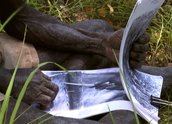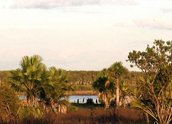


The Balanda and the Bark Canoes (2006)
Synopsis
This documentary is about the making of Ten Canoes (2006), a feature film partly inspired by the photographs of Donald Thomson from the 1930s.
Curator’s notes
The Balanda and the Bark Canoes is a fascinating look at making a film that must take into account two cultural perspectives, beliefs and storytelling traditions. It is at times very humorous, especially when the explanations of director Rolf de Heer to the actors from Ramingining and Murwangi get lost in translation. What results is often a different understanding by the actors of what de Heer is asking for.
The task undertaken by de Heer in order to make Ten Canoes (2006) is of a very complex nature, with the process and understanding of storytelling completely different between Western and Indigenous cultures. De Heer, in working with the actors, must comply with cultural kinship systems, making sure that their characters in the film are either married to their real life partners or at least could be. It is interesting to see these real world constraints imposed upon a fictional story, which is then shaped by real culture and tradition. In the end, it was the community who cast the film.
The people of Ramingining and Murwangi recreate the canoe-making process from the 1930s photographs of anthropologist Donald Thomson. In a strange twist, it is Thomson who becomes the authority on Yolngu culture and the making of the bark canoes and de Heer, in referring to Thomson’s notes, is elected as an elder with 'great wisdom’.
What comes across clearly in the documentary is that the motivation of the Indigenous peoples is very much to respect and remember their ancestors, as well as to gain respect from Balanda (white) culture. The voice-over narration sometimes seems a little anthropological and paternalistic, but de Heer is essentially present to facilitate a story that the people of Ramingining and Murwangi want to tell through acting. One of the participants declares, 'I will act so my grandfather is remembered’, and this pretty much sums up the motivation for the Indigenous actors, who are taken on a journey of remembering.
The Balanda and the Bark Canoes gives a good background to Ten Canoes (2006, see on this site), and both films represent a meeting of cultures.
In 2008 the Yolngu people of Ramingining produced a website, Twelve Canoes, to share their paintings and stories and as a way of keeping alive their culture.
- Overview
- Curator’s notes
- Video 3 clips

- Principal credits
- Find a copy
- Make a comment
- Map
- Add your review



